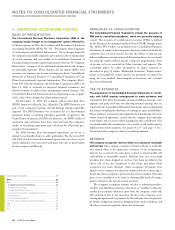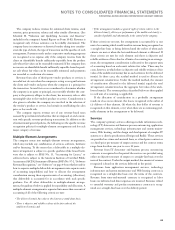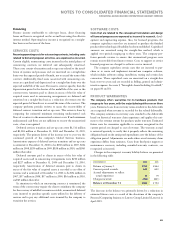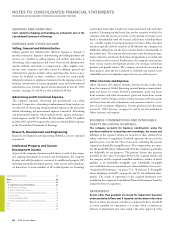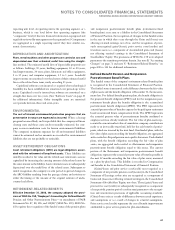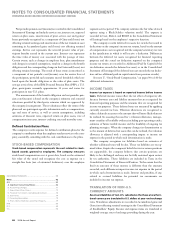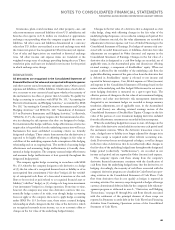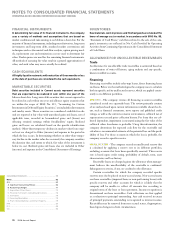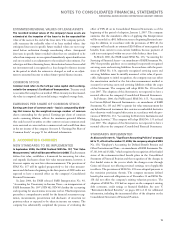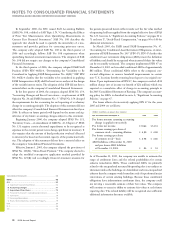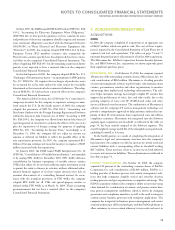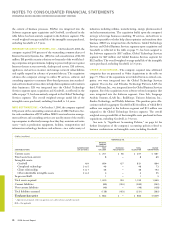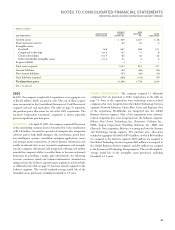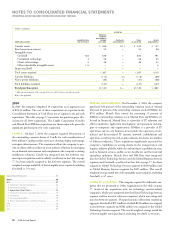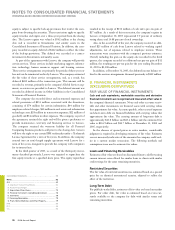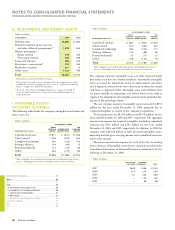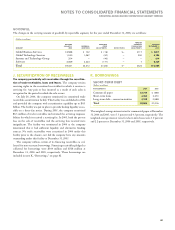IBM 2006 Annual Report Download - page 74
Download and view the complete annual report
Please find page 74 of the 2006 IBM annual report below. You can navigate through the pages in the report by either clicking on the pages listed below, or by using the keyword search tool below to find specific information within the annual report.
In September 2006, the SEC issued Staff Accounting Bulletin
(SAB) No. 108, codified as SAB Topic 1.N, “Considering the Effects
of Prior Year Misstatements when Quantifying Misstatements in
Current Year Financial Statements.” SAB No. 108 describes the
approach that should be used to quantify the materiality of a mis-
statement and provides guidance for correcting prior-year errors.
The company early adopted SAB No. 108 in the third quarter of
2006 and accordingly, follows SAB No. 108 requirements when
quantifying financial statement misstatements. The adoption of SAB
No. 108 did not require any changes to the company’s Consolidated
Financial Statements.
In the third quarter of 2006, the company adopted FASB Staff
Position (FSP) FIN 46(R)-6, “Determining the Variability to Be
Considered in Applying FASB Interpretation No. 46(R).” FSP FIN
No. 46(R)-6 clarifies that the variability to be considered in applying
FASB Interpretation 46(R) shall be based on an analysis of the design
of the variable interest entity. The adoption of this FSP did not have a
material effect on the company’s Consolidated Financial Statements.
In the first quarter of 2006, the company adopted SFAS No. 154,
“Accounting Changes and Error Corrections—a replacement of APB
Opinion No. 20 and FASB Statement No. 3.” SFAS No. 154 changed
the requirements for the accounting for and reporting of a voluntary
change in accounting principle. The adoption of this statement did not
affect the company’s Consolidated Financial Statements in fiscal year
2006. Its effects on future periods will depend on the nature and sig-
nificance of any future accounting changes subject to this statement.
Beginning January 2006, the company adopted SFAS No. 151,
“Inventory Costs—an amendment of ARB No. 43, Chapter 4.” SFAS
No. 151 requires certain abnormal expenditures to be recognized as
expenses in the current period versus being capitalized in inventory. It
also requires that the amount of fixed production overhead allocated
to inventory be based on the normal capacity of the production facili-
ties. The adoption of this statement did not have a material effect on
the company’s Consolidated Financial Statements.
Effective January 1, 2005, the company adopted the provisions of
SFAS No. 123(R), “Share-Based Payment.” The company elected to
adopt the modified retrospective application method provided by
SFAS No. 123(R) and accordingly, financial statement amounts for
the periods presented herein reflect results as if the fair value method
of expensing had been applied from the original effective date of SFAS
No. 123. See note A, “Significant Accounting Policies,” on pages 62 to
71 and note U, “Stock-Based Compensation,” on pages 96 to 100 for
additional information.
In March 2005, the FASB issued FASB Interpretation No. 47,
“Accounting for Conditional Asset Retirement Obligations, an inter-
pretation of FASB Statement No. 143” (FIN 47). FIN 47 clarifies that
conditional asset retirement obligations (AROs) meet the definition
of liabilities and should be recognized when incurred if their fair values
can be reasonably estimated. The company implemented FIN 47 on
December 31, 2005 and recorded conditional AROs of approximately
$85 million. These conditional AROs relate to the company’s con-
tractual obligations to remove leasehold improvements in certain
non- U.S. locations thereby restoring leased space to its original con-
dition. Upon implementation of FIN 47, the company recorded a $36
million charge (net of income tax benefit of $21 million) which was
reported as a cumulative effect of change in accounting principle in
the 2005 Consolidated Statement of Earnings. The company’s account-
ing policy for AROs is described in note A, “Significant Accounting
Policies,” on page 67.
Pro forma effects of retroactively applying FIN 47 for the years
2005 and 2004 are as follows:
(Dollars in millions except per share amounts)
FOR THE YEAR ENDED DECEMBER 31: 2005 2004
Pro forma amounts assuming accounting
change is applied retroactively:
Pro forma net income $, $,
Pro forma earnings per share of
common stock—assuming dilution $ . $ .
Pro forma earnings per share
of common stock—basic $ . $ .
ARO liabilities at December 31, 2005
and pro forma ARO liabilities
at December 31, 2004 $ $
As of December 31, 2005, the company was unable to estimate the
range of settlement dates and the related probabilities for certain
asbestos remediation AROs. These conditional AROs are primarily
related to the encapsulated structural fireproofing that is not subject to
abatement unless the buildings are demolished and non-encapsulated
asbestos that the company would remediate only if it performed major
renovations of certain existing buildings. Because these conditional
obligations have indeterminate settlement dates, the company could
not develop a reasonable estimate of their fair values. The company
will continue to assess its ability to estimate fair values at each future
reporting date. The related liability will be recognized once sufficient
additional information becomes available.
NOTES TO CONSOLIDATED FINANCIAL STATEMENTS
INTERNATIONAL BUSINESS MACHINES CORPORATION AND SUBSIDIARY COMPANIES
72 2006 Annual Report
Consolidated Statements .........................................................
Notes .....................................................................................
A-G ......................................................................................... 62
A. Significant Accounting Policies ....................................... 62
B. Accounting Changes........................................................ 71
C. Acquisitions/Divestitures ................................................. 73
D. Financial Instruments (excluding derivatives) ................ 78
E. Inventories ....................................................................... 79
F. Financing Receivables ...................................................... 79
G. Plant, Rental Machines and Other Property ................... 79
H-M ......................................................................................... 80
N-S .......................................................................................... 88
T-X .......................................................................................... 96
Black
MAC
390 CG10


